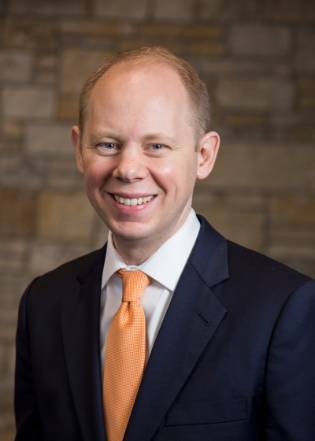Stepping into his presidency at Michigan-based Hope College in 2019, Matthew A. Scogin acknowledged that higher education had “never been more important.” Yet, it also had “never been more cost prohibitive.”
As of 2021, student loan debt has amounted to $1.7 trillion in the United States, the Board of Governors of the Federal Reserve System reported.
 Matthew A. Scogin
Matthew A. ScoginScogin’s efforts became focused on solving the affordability challenge. Years later, the solution was announced, with a new financial strategy called “Hope Forward.”
Using the three pillars of accessibility, generosity and community, Hope Forward is modeled as a pay-it-forward design. Rather than pay tuition up front, students are instead asked to provide gifts of any amount each year to the college after graduation. Only payments of room and board are required while completing classes.
“It’s really about thinking of ourselves as a learning community and moving away from what too often feels like a transactional relationship with students,” Scogin’s said. “Our view is that students could be students, not customers. And to the extent institutes of higher learning think of students as customers, we actually think that’s toxic to a robust learning environment.”
With a goal of assessing the impact and logistics, a pilot program with 22 students is set to be launched this fall. To be eligible, students had to reside outside of the Midwest, hold a minimum 3.0 GPA and write an essay about an area of “hopelessness” they would like to address. Zoom interviews were then held to narrow down candidates.
“One thing that we are seeing in students is that they may come into college with big dreams about changing the world,” said Scogin. “But as they graduate, they’re so burdened by debt that often students will give up on their dreams in order to take a job that will pay the bills.”
To fund the program, $27 million has currently been raised. But in order to eventually reach 100% tuition coverage for all students, the endowment must exceed over $1 billion.
Beyond raising money for the new tuition model, Hope College has reduced its spending and pushed for an additional $1 million to fund scholarships. This year, tuition also remained flat.
“All of those things, while important, really are just tweaks to the old system,” said Scogin. “What we are imagining with Hope Forward is an entirely new system. A system that no longer relies on tuition at all. While we are in this transition phase, we are doing our best to make what’s called the old system or tuition-based system as affordable as possible.”
Miles away from Michigan, another college president sought to increase access to meet the needs of the changing demographics.
For decades, the population of diverse students remained at 8% at Unity College in Maine. That is until the college’s transition to a hybrid learning model last summer.
 Dr. Melik Peter Khoury
Dr. Melik Peter KhouryNow, students have the opportunity to choose in-person, fully online or hybrid pathways to complete their education. Additionally, the model also moved away from the traditional two semesters model to eight terms.
Though the shift has received mixed reviews from the campus community, the college nicknamed “America’s Environmental College” has received a surge in enrollment, increasing from 868 full-time students to more than 1,800 in just over a year. The number of diverse students also rose to 18%.
Dr. Melik Peter Khoury, president and CEO of Unity College, credits both the new model and quality of its faculty and staff in the boost in enrollment.
“We are a long way from where we need to be,” he said. “But just by shifting to this model 18 months ago, we are seeing an impact on access and on flexibility for the kind of students who have been historically unable to afford or even been interested in careers in environmental science, which is critical for our survival long term.”
The increase in flexibility and access has led to a reduction in student loans at the institution. Between the 2019-2020 and 2020-2021 school year, student loans decreased from $3.5 million to $1 million, according to Unity.
In addition to this model, the college also announced the establishment of the Technical Institute for Environmental Professions, which offers associate degrees and certificates through synchronous and in-person learning.
“What we found over multiple years of research, it was not that our degrees or curriculum were not relevant,” said Khoury. “It was just inaccessible to most. We change that by just providing a little bit more flexibility, a little more affordability, a little bit more accessibility and then having a willing group.”
Sarah Wood can be reached at [email protected].



















